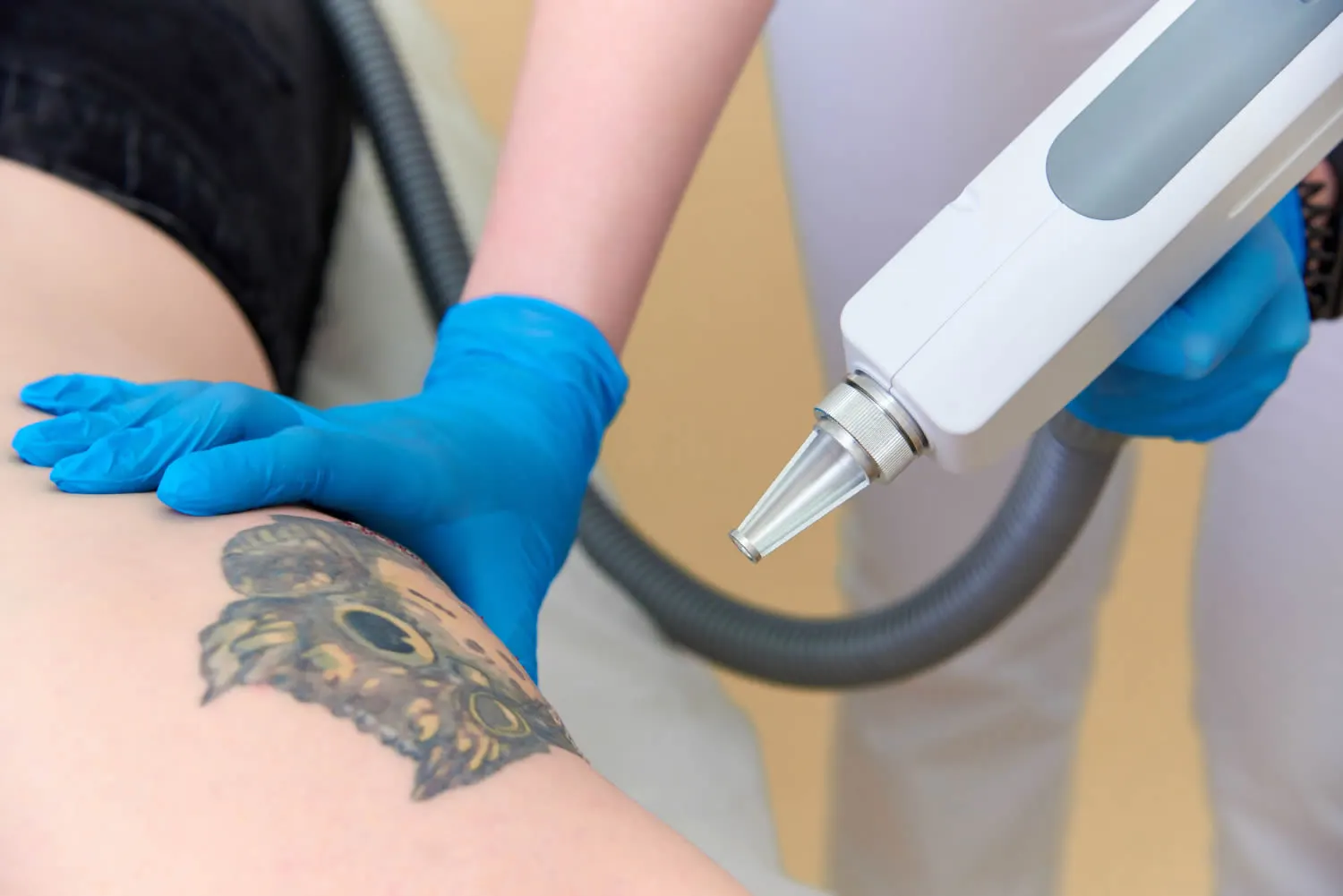In the vibrant tapestry of modern self-expression, tattoos have etched their mark, turning skin into canvases of personal stories and artistic flair. However, as the allure of inked designs continues to captivate, the flip side—tattoo removal—has surged in relevance. Whether driven by changing tastes, professional considerations, or personal regrets, the journey to erase a tattoo is as significant as the decision to get one.
Understanding the impact of tattoo removal on skin health is crucial. This isn’t just about aesthetics; it’s about the intricate interplay between ink and the body’s largest organ. Furthermore, the burgeoning field of dermatological research offers a window into safer, more effective removal techniques, promising a future where regrets aren’t etched in permanence.
In this article, we dive deep into the world of tattoo removal, unraveling the methods, exploring their immediate and long-term effects on skin health, and examining the strides made in dermatological research. By the end, you’ll not only grasp the complexities involved but also appreciate the nuanced science driving these procedures.
Overview of Tattoo Removal Methods
Tattoo removal, like the art of tattooing itself, has evolved dramatically over the years. Gone are the days when removal meant crude and painful methods with questionable results. Today, several sophisticated techniques offer varying degrees of success and comfort.
Laser Tattoo Removal
Laser tattoo removal stands at the forefront, utilizing high-intensity light beams to break down the ink particles in the skin. Different wavelengths target different ink colors, fragmenting them so the body’s immune system can gradually remove them. While highly effective, this method requires multiple sessions and can be quite costly.
Surgical Excision
Surgical excision involves cutting out the tattooed skin and stitching the surrounding skin together. This method guarantees complete removal but is typically reserved for small tattoos due to the risk of scarring. It’s a quick fix but leaves a permanent reminder of the tattoo’s existence.
Dermabrasion
Dermabrasion, though less common today, involves sanding down the skin to remove the upper layers where the ink resides. This method can be quite painful and has a significant recovery period. The results vary widely, and there’s a higher risk of scarring compared to laser treatments.
Topical Creams
Over-the-counter topical creams promise tattoo removal but often fall short of their claims. These creams aim to fade tattoos over time but generally lack the potency to remove them entirely. They are best seen as a supplementary treatment rather than a standalone solution.
In recent years, advancements in technology have introduced more refined laser techniques, such as the Q-switched lasers and the newer picosecond lasers, which offer faster and more efficient ink removal with less damage to the surrounding skin.
Immediate Effects of Tattoo Removal on Skin
Undergoing tattoo removal is not a walk in the park. The skin, having embraced the ink, now endures the process of its extraction, which brings a suite of immediate effects.
Pain and Discomfort
Laser tattoo removal, the most prevalent method, is often likened to the sensation of hot grease splashing on the skin. The level of pain varies depending on the individual’s pain threshold and the tattoo’s size and location. Local anesthesia can help mitigate this discomfort, but it’s an unavoidable part of the process.
Swelling and Redness
Post-procedure, the treated area typically experiences swelling and redness. This is the skin’s natural inflammatory response, signaling the beginning of the healing process. Cold compresses and anti-inflammatory medications can alleviate these symptoms, which generally subside within a few days.
Blistering
Blisters often form within 24 hours of the laser treatment. While alarming to some, blistering is a normal reaction and indicates that the body is working to expel the ink. These blisters eventually crust over and fall off, revealing new skin underneath.
Infection Risks
The risk of infection is a serious consideration. The treated area is essentially a wound, and proper aftercare is paramount. Keeping the area clean and avoiding activities that could introduce bacteria to the wound (like swimming) are crucial for preventing infections.
To minimize these immediate side effects, it’s essential to follow the aftercare instructions provided by the dermatologist or laser technician. These typically include keeping the area dry and protected, applying prescribed ointments, and avoiding sun exposure.
Long-term Effects on Skin Health
Tattoo removal doesn’t just leave temporary marks; its impacts can linger long after the ink has faded. The long-term effects on skin health are a testament to the body’s resilience and the sophistication of modern dermatological practices.
Scarring and Skin Texture Changes
Scarring remains one of the most significant concerns. While modern techniques like laser removal are designed to minimize damage, the risk of scarring cannot be entirely eliminated, especially for those prone to keloids or hypertrophic scars. The texture of the skin can also change, feeling different to the touch compared to untreated areas.
Hyperpigmentation and Hypopigmentation
Another common issue is pigmentation changes. Hyperpigmentation (darkening of the skin) and hypopigmentation (lightening of the skin) can occur, particularly in individuals with darker skin tones. These conditions result from the disruption of melanin production in the treated area. While often temporary, in some cases, these changes can be permanent.
Allergic Reactions
Though rare, allergic reactions to the breakdown products of the tattoo ink can occur. As the laser breaks down the ink particles, the body’s immune response can sometimes trigger allergic reactions, leading to rashes or itchiness around the treated area.
Studies on Skin Recovery
Dermatological studies have focused extensively on skin recovery post-tattoo removal. Research shows that with proper care and time, most skin types can recover well. Advanced treatments, including the use of topical retinoids and silicon-based scar treatment gels, have shown promise in enhancing skin regeneration and minimizing long-term effects.
Understanding these potential long-term impacts is crucial for anyone considering tattoo removal. Informed decisions and realistic expectations can make the journey smoother and more satisfying.
Dermatological Research on Tattoo Removal
Tattoo removal isn’t just a cosmetic concern; it’s a field ripe with scientific inquiry and technological advancement. Dermatological research continues to push the boundaries of what’s possible, aiming to make tattoo removal safer, more effective, and less invasive.
Key Research Studies and Findings
Several pivotal studies have shaped our current understanding of tattoo removal. Research has delved into the physics of laser-tattoo interaction, optimizing the wavelengths and pulse durations to target different ink colors more effectively. These studies have led to the development of more efficient lasers that reduce treatment times and improve outcomes.
Evolution of Tattoo Removal Techniques
The evolution of tattoo removal techniques is a testament to the relentless pursuit of improvement. Early laser systems were often limited by their inability to target all ink colors effectively. Modern advancements, including the introduction of picosecond lasers, have revolutionized the field. These lasers emit pulses at trillionths of a second, fragmenting ink particles more finely and facilitating faster removal with fewer side effects.
Role of Clinical Trials
Clinical trials play a crucial role in advancing tattoo removal techniques. These trials test new technologies, assess their safety, and compare their effectiveness against existing methods. For instance, recent trials have explored the use of fractional lasers, which create micro-injuries in the skin to promote faster healing and reduce scarring.
Future Directions
The future of tattoo removal holds exciting possibilities. Researchers are exploring non-laser techniques, such as perfluorodecalin (PFD) patches, which can be applied post-laser treatment to enhance ink clearance and reduce recovery times. Additionally, advancements in nanotechnology could pave the way for targeted removal creams that dissolve ink without the need for lasers.
Dermatological research continues to illuminate the path forward, promising a future where tattoo removal is not only effective but also gentle on the skin.
Patient Education and Best Practices
Navigating the tattoo removal process requires more than just technical expertise; it demands informed decision-making and diligent aftercare. Patient education and adherence to best practices are the pillars of a successful tattoo removal journey.
Setting Realistic Expectations
One of the most critical aspects of patient education is setting realistic expectations. Tattoo removal is a process, often requiring multiple sessions over several months. Patients should understand that complete removal might not always be possible, and some ink colors, particularly lighter shades, can be more challenging to erase.
Understanding Potential Risks
Educating patients about potential risks and complications is essential. This includes discussing the likelihood of pain, scarring, pigmentation changes, and the importance of following aftercare instructions meticulously. Awareness of these risks empowers patients to make informed decisions and prepares them for the journey ahead.
Best Practices for Skin Care
Proper skin care before, during, and after tattoo removal is crucial for optimal outcomes. Pre-treatment care might involve avoiding sun exposure and discontinuing certain skincare products that could irritate the skin. During the treatment period, maintaining cleanliness and moisture in the treated area is vital. Post-treatment care focuses on preventing infections and promoting healing.
Choosing Qualified Professionals
The expertise of the practitioner performing the tattoo removal cannot be overstated. Choosing qualified professionals with experience in tattoo removal ensures that the procedures are performed safely and effectively. Patients should seek out board-certified dermatologists or licensed laser technicians with a proven track record in tattoo removal. For those in major cities like Sydney, it is advisable to research and find reputable clinics offering tattoo removal Sydney services, ensuring access to skilled professionals and the latest technology.
In conclusion, while tattoo removal is a complex process, being well-informed and prepared can significantly enhance the experience and outcomes. The journey from regret to relief is paved with knowledge, care, and the expertise of skilled professionals.
Conclusion
Tattoo removal, a journey marked by both physical and emotional challenges, underscores the profound connection between body art and personal evolution. The decision to remove a tattoo is as deeply personal as the decision to get one, reflecting changing identities, aspirations, and life circumstances.
Understanding the impact of tattoo removal on skin health is paramount. From the immediate effects like pain and blistering to the long-term challenges of scarring and pigmentation changes, each step of the process demands careful consideration and informed choices. Dermatological research continues to advance, offering hope for more effective and less invasive solutions in the future.
Patient education and best practices play a crucial role in navigating this journey. By setting realistic expectations, understanding potential risks, and adhering to recommended care protocols, individuals can significantly enhance their tattoo removal experience.
Ultimately, tattoo removal is more than just a cosmetic procedure; it’s a testament to the resilience of the human spirit and the remarkable capabilities of modern dermatological science. As we look to the future, the promise of safer, more efficient tattoo removal methods offers a reassuring glimpse into the ever-evolving landscape of skin health and personal transformation.
Keep an eye for more latest news & updates on Internal Insider!










